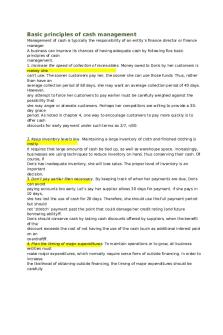Chapter 40 Basic Principles of Animal Form and Function PDF

| Title | Chapter 40 Basic Principles of Animal Form and Function |
|---|---|
| Course | AP Biology |
| Institution | High School - USA |
| Pages | 2 |
| File Size | 64.6 KB |
| File Type | |
| Total Downloads | 31 |
| Total Views | 151 |
Summary
This chapter in AP Bio focuses on animal form and function. It takes a look at how different animals evolved and why they evolved that way. ...
Description
Chapter 40: Basic Principles of Animal Form and Function 1) You must know: the importance of homeostasis and examples. How feedback systems control homeostasis. One example of positive feedback and one example of negative feedback. 2) Tissues are groups of cells that have a common structure and function. 3) Organs are a group of tissues. 4) Organ systems are groups of organ working together, examples include digestive, circulatory, and excretory system. 5) Endocrine system and nervous system specialize in control and coordination. 6) In the endocrine system, chemical signals called hormones are released into the bloodstream and are broadcast through the body. 7) A hormone can only affect a cell with specific receptors for the released hormones. 8) In the nervous system neurons transmit information between specific locations. 9) Neurons, muscle cells, and endocrine cells are the only cells that receive nerve impulses. 10) Homeostasis is when animals maintain a relatively constant internal environment even when the external environment changes significantly. 11) You should concentrate on knowing any change in a system affects it, from the levels of cells through an ecosystem. This topic offers many good examples of positive and negative feedback and how small changes can affect a system. 12) Homeostatic control systems function by having a set points (like a body temperature to maintain). Sensors to detect any stimulus above or below the set point, and a physiological response that helps return the body to its set point. 13) Negative-feedback systems the animal responds to the stimulus in a way that reduces the stimulus. For example in response to exercise the body temperature rises, which initiates sweating to cool the body. More gets you less. 14) Positive-feedback systems a change in some variable triggers mechanisms that amplify rather than reverse the change. For example during childbirth, pressure of the baby’s head against receptors near the opening of the uterus stimulates greater uterine contractions, which cause greater pressure against the uterine opening, which heightens the contractions and so forth. More gets you more. 15) Thermoregulation refers to how animals maintain their internal temperature within a tolerable range. It may involve physiological changes such as painting, sweating, shivering, or behaviors such as burrowing and sunning. 16) Endotherms (mammals and birds) are warmed mostly by heat generated by metabolism. Ectotherms (invertebrates, fishes, amphibians, and reptiles) generate relatively little metabolic heat, gaining most of their heat from external sources.
17) Both birds and mammals rely on countercurrent exchange to reduce heat loss. Heat is transfer involves antiparallel arrangement of blood vessels such that warm blood from the core of the animal, en route to the extremities, transfers heat to colder blood returning from extremities. Heat that would have been lost to the environment is conserved in the blood returning to the core of the animal. 18) Metabolic rate is the total amount of energy it uses in a unit of time. Metabolic rate are generally higher for endotherms than for ectotherms. 19) Metabolic rate is inversely related to body size among similar animals. For example, elephants have a slower metabolic rate, whereas mice have a very fast metabolic rate. 20) Torpor involves a decrease in metabolic rate, conserving energy during environmental extremes. Animals may enter torpor in winter (hibernation), summer (estivation), or during sleep periods (daily torpor)....
Similar Free PDFs

Basic Principles of Microbiology
- 6 Pages

Vet Form and Function Notes
- 102 Pages

Basic Principles of ultrasound
- 38 Pages

Basic Principles OF Fascism
- 5 Pages

Basic Principles of Heredity
- 23 Pages

BASIC PRINCIPLES OF TAXATION
- 46 Pages

2-Basic Principles of Heredity
- 23 Pages

Basic Principles of Power Electronics
- 312 Pages

1. Basic Principles of Economics
- 3 Pages
Popular Institutions
- Tinajero National High School - Annex
- Politeknik Caltex Riau
- Yokohama City University
- SGT University
- University of Al-Qadisiyah
- Divine Word College of Vigan
- Techniek College Rotterdam
- Universidade de Santiago
- Universiti Teknologi MARA Cawangan Johor Kampus Pasir Gudang
- Poltekkes Kemenkes Yogyakarta
- Baguio City National High School
- Colegio san marcos
- preparatoria uno
- Centro de Bachillerato Tecnológico Industrial y de Servicios No. 107
- Dalian Maritime University
- Quang Trung Secondary School
- Colegio Tecnológico en Informática
- Corporación Regional de Educación Superior
- Grupo CEDVA
- Dar Al Uloom University
- Centro de Estudios Preuniversitarios de la Universidad Nacional de Ingeniería
- 上智大学
- Aakash International School, Nuna Majara
- San Felipe Neri Catholic School
- Kang Chiao International School - New Taipei City
- Misamis Occidental National High School
- Institución Educativa Escuela Normal Juan Ladrilleros
- Kolehiyo ng Pantukan
- Batanes State College
- Instituto Continental
- Sekolah Menengah Kejuruan Kesehatan Kaltara (Tarakan)
- Colegio de La Inmaculada Concepcion - Cebu






